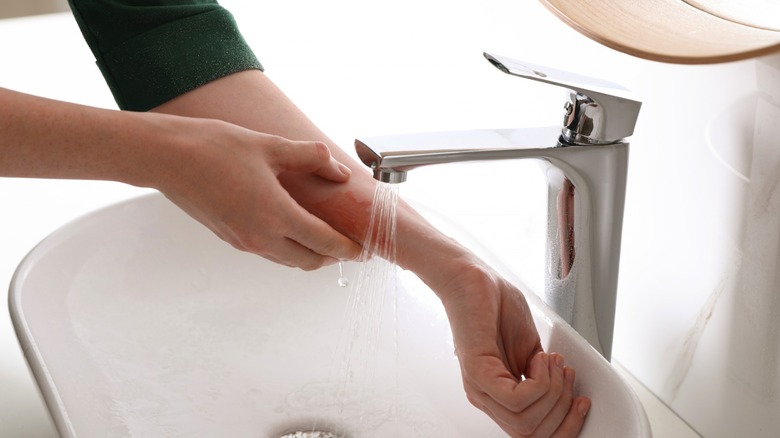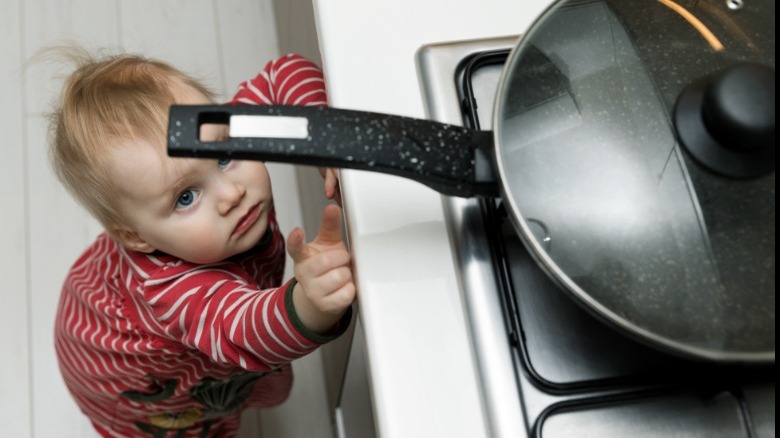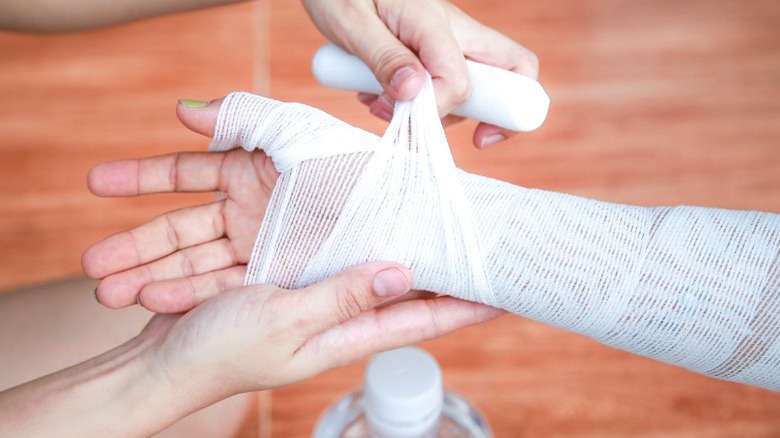Will A First-Degree Burn Heal On Its Own?
Nearly half a million Americans visit the ER for some type of burn injury each year, according to the Cleveland Clinic. Chances are the total number of burn injuries is higher if you include more minor burns that could be treated at home. For instance, both first-degree and second-degree burns rarely involve hospitalization.
In fact, the American Academy of Dermatology Association (AAD) states that first-degree burns are common and usually heal on their own. Often the result of accidentally touching items we encounter day-to-day such as a hot stove or curling iron, or over-exposing our skin to the sun, first-degree burns only impact the top layer of your skin, resulting in redness, pain, and sometimes mild swelling.
Though not severe, if your first-degree burn is especially painful and covers a wider area, it is probably best to treat it rather than wait for the burn to heal without any attention. At the very least, by treating the burn you will alleviate some of the discomforts as the burn heals. Some ways to treat a first-degree burn include holding a cold compress on the affected area for about 10 minutes, applying petroleum jelly a few times a day, and taking an over-the-counter pain reliever to reduce pain and swelling, per AAD.
Other burn degrees explained
Your skin is your largest organ and serves as a multi-layer of protection for your body. Johns Hopkins Medicine explains that first-degree burns only impact the outermost layer of your skin, or epidermis. When burned, the epidermis rarely experiences long-term tissue damage. The dermis — which contains blood vessels, hair follicles, sweat glands, nerves, and various tissues — forms the middle layer of your skin. When you have a second-degree burn, the dermis is partially impacted. A third-degree burn affects both the dermis and epidermis and may impact the deepest layer of the skin called the subcutis. The subcutis helps maintain your body's heat and serves as a "shock absorber" to protect you against injury.
If you have a second-degree burn, Healthline states that you will likely develop blisters and that the wound will eventually become covered by scab-like tissue. Even so, second-degree burns do not typically leave a scar, though the full healing process could take at least three weeks. Healing can take longer if the blister is severe.
A third-degree burn is the most damaging. While you may think third-degree burns would be excruciatingly painful, this severe burn often damages the nerves, and so those with third-degree burns may not experience any pain, per Johns Hopkins Medicine. Depending on the cause, third-degree burns can vary in appearance but are often raised up and leathery-looking with a waxy, white coloring. Expect third-degree burns to leave scars without surgical intervention (via Healthline).
When to seek medical treatment for a burn
People with burn injuries can be susceptible to infection, but it's not always easy to determine if a burn is infected since burns and infections exhibit some similar characteristics (via Mount Sinai). However, if you notice the area around the wound changing color or growing deeper into the skin, see greenish pus, or you're feeling feverish, it's imperative that you contact a healthcare specialist. You should also contact a doctor if your burn injury leads to dehydration due to the body losing fluids through the skin. Signs of dehydration include thirst, dizziness, weakness, and less frequent urination, among others. Dehydration occurs with more extreme and widespread burn injuries and can become a life-threatening situation.
If you've returned home after being hospitalized for burns, it's vital that you continue to monitor your injury as it heals and contact your doctor if you notice persistent redness beyond the wound area, swelling, greenish-yellowish drainage, a foul odor coming from the wound area, increased pain, or your skin feels hot to the touch, per University of Iowa Hospitals & Clinics.
Risks of getting burned are all around us, such as exposed electrical cords, flammable materials, hot containers, careless smoking, and excessive sun exposure. Experts advise installing a smoke detector, quitting smoking, and reducing time in the sun to minimize your chance of injury.



